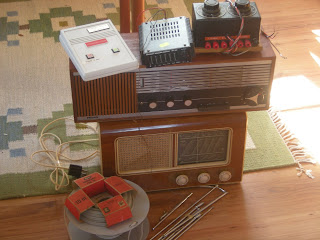A blog about Amateur Radio, Medium Wave DX-ing, Electronics and Technology in general by Eric, SA5BKE.
Friday, April 30, 2010
WSPR receive and flea market
Using the same equipment and QTH as last time I now finally tried the WSPR system that I´ve heard a lot about lately. I only run with receive but I hope to be able to transmit sometime soon. Basically WSPR is a narrow digital mode to be used as a beacon. When you receive and decode a WSPR station, which is done automatically in the software, it uploads the spot to a central database and can be tracked by other users.
Here are a few links to get more information about WSPR:
http://wsprnet.org/drupal/
http://www.physics.princeton.edu/pulsar/K1JT/wspr.html%20
Here are the 2 most noteworthy catches in terms of power and distance:
G4PEC 30m 0.001W 1060km
RA9CUA 17m 2W 2710km
The complete log can be found here:
WSPR log SA5BKE 20100417
This weekend I also went to some flea markets to look for interesting equipment. I came home with these things:
2 Valve radios that of course included variable capacitors, an old box with big variable resistors, some kind of alarm controller (atleast a box for other project) and an equalizer. Also got some telescopic antennas and cables (twin lead and speaker cable). I didn´t pay much, so I think it was a bargain!
Sunday, April 11, 2010
QS1R, WinradHD and Solar Storm
I´ve had the QS1R receiver for about 1,5 years now. It´s a great receiver, one of the most advanced software defined radios that you can get among those aimed for private use. The major reason why I bought it instead of the Perseus is the openness. All code is GPL! The software architecture is really first class, where DSP are done in a server process and the GUI is in another one.
The major drawback with the current state of QS1R software is unfortunately that it lacks spectrum recording, maybe the most important feature for a DX listener. The idea of recording a wide bit of the AM band on top of the hour and then be able to go over every interesting frequency at a later time is something we have got used to. Luckily I can use the QS1R with another software, Winrad orginally developed by Alberto I2PHD, that supports recording. A new version of an alternative version of Winrad called WinradHD was recently released and also a new DLL plugin for QS1R was released also. Now I can record up to 2 MHz wide but I only need around 1200 kHz (1710 - 530). A lot of HD is needed.
I tried to listen for DX on the morning of 5th of April with only a mini whip antenna (designed by PA0RDT), see top image. K-index was from 3-7 so no transatlatic DX was noted I thought at first and we are also late in the season, but after a closer look on the files I see that there are some sunrise improvements and around 0400 UTC there are some Latin American stations on the higher portion of the band (1400 - 1600). I´ve not had time to go through them so I can put definite IDs but my guess is that it´s stations from Venezuela, Colombia and Peru. I hope to try this receiving setup more during the Spring.
Subscribe to:
Posts (Atom)




